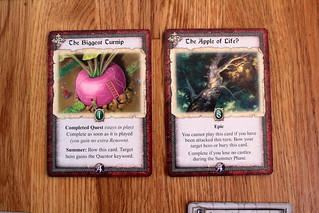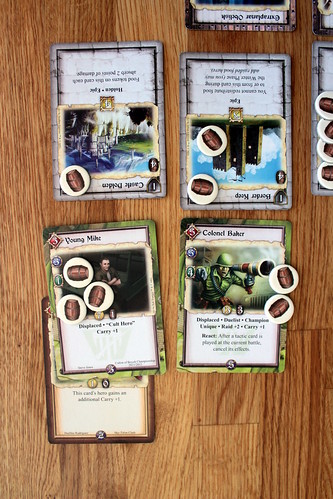| Strategy | Luck |
|---|---|
| Interaction | Components & Design |
| Complexity | Score |

The setting of the game is almost as unlikely. The world of Countermay is a sort of multiversal crossroads, a place where “threads converge in the Tapestry of Worlds”. A place of unlikely meetings between very different cultures: the arthurian Kingdom of Holden and the undead, Egypt-inspired Dread Army of Ixhasa right next to a platoon of World War 2 GIs styling themselves The Displaced and the enigmatic, alien Ord. Nine factions in all, five of which are represented in this box with premade decks. And as always when very different cultures meet, the result is war. A thousand years of it. And now Countermay is dying, starvation threatens the nine empires. Only one will survive.
As complex as the creation and setting of the game are, however, the rules can keep up with it. Romance of the Nine Empires is nowhere close to a simple game, and to get all the details it’s recommended that you play four games with different decks, each adding another aspect of the game. The first game is, obviously, the most straightforward of them, a military matchup between the alien Ord and the Viking-like Malchior. Each side starts with its Stronghold and a number of Castles in the game. The Stronghold provides a starting income and a faction-specific ability, but it’s the Castles that keep your empire going. They are where you store your food. Lose all your Castles and your out of the game. Have no food in them in winter and, guess what, you also lose. You can’t get any more Castles, and getting more food isn’t easy either. Making things worse, food is needed to pay for all sorts of cool stuff.
Each round of the game is split into four seasons: Spring, where your straighten all your bowed cards (untap them, in general CCG terminology), Summer, where all the action happens, and Winter where you draw new cards. Autumn doesn’t exist in the first game. Like I said, Summer is where the fun happens: buying new cards and going to war. Cards you buy fall into different categories. Properties are relatively boring, they tap – sorry, bow – for money that buys more cards and may bring a special ability to the table, but they don’t go to war. That’s what Heroes do, Heroes equipped with Items and followed by their Cohorts.Some heroes, those with the Wizard keyword, can equip Spells, too. You won’t have a well-equipped hero with all that shiny stuff in the first two years, though, for lack of money. Summer passes by players taking turns to play cards or, once per year, go to Battle.

Battle is where things get complex, it starts a new phase that interrupts Summer. You can send any number of Units – that is, Heroes with their Cohorts and equipment – to attack one or more enemy Castles. Your opponent sends any number of his own Units to defend. Then you take turns again, this time using Battle abilities from your cards, playing red Tactics cards from your hand or engaging your cards, dealing the cards Strength in damage – only once per card though, engaging bows them. When you do damage, the other army has to absorb it. Heroes and Cohorts absorb their Strength value in damage. There is, however, no such thing as injury, one point of damage will destroy whatever it hits. The advantage of higher Strength is that less damage remains to be absorbed by other cards. When absorbing damage with your Heroes you may discard cards from your hand to absorb more damage, as the defender you may also discard food tokens to do the same. Finally, a Castle can always absorb all damage remaining, but is destroyed just like everything else – that’s a very bad thing, but sometimes preferable to absorbing damage with Heroes that you might want to use in a counterattack. The attacker, who can not absorb damage with food tokens, can instead declare his Heroes Immune to damage if the initial damage is less than the Hero’s Strength. All that means is that Heroes declared Immune do not have to absorb damage, even when there is damage left to absorb. You can’t kill an attacker with a scratch to the arm like you can a defender. This is one thing that could have done with a better explanation in the terse, compact Battle rules, it took us some discussion before we, hopefully, got it right.

The first game will probably end by war, with someone using their last Castle. The second game introduces The Displaced, who are Raiders at heart. Raids are what happens in Autumn: if you have any Heroes left alive and unbowed after the Summer’s battles, you can send them to an enemy Castle now. Again, the owner can send a Hero to defend. But they don’t fight this time, they sneak around. The value of a face-down card, with bonuses from Raid abilities, determines the winner. If that is the attacker, he takes a food token with him, plus one more for every point of Carry his unit has.
Game number three doesn’t add any new rules, but one player gets to play the Dread Army of Ixhasa deck which is labelled a control-deck. In this game, that basically means that you force your opponent into spending more food than you and starve him that way. The strategy goes well with the undead, they just keep coming back while everyone else has to pay for new Heroes. Game number four, then, introduces yet another way to win the game. The Kingdom of Holden specialises in questing to boost their Renown, eventually making other players’ peasants join them because they’re just that popular. Quests are another type of card that only the Holden have in their premade deck. To play a quest card, you need Heroes with enough combined Glory, and unless they have the Questor keyword you have to bow them, making them unavailable for Battle and Raiding. How you complete a quest depends entirely on the quest: it may require you to successfully raid an opponent while not being victim of a raid yourself, to destroy a Castle, to simple commit a certain number of Heroes to it for a year or, in the easiest case, to do nothing. The quest ‘The Biggest Turnip’ completes as soon as you play it. All quests reward you with Renown, and if you collect enough you win in winter, but the Popular Victory is hard to achieve as you have to defend yourself at the same time. The Holden are harder to play than the other faction.
Once you made it through all the introduction game, you’re ready for the real thing: play any faction pairing, play the more complex game with more than two players or customize your deck with the supply of extra cards in the box. That’s fun and all, but I really miss more cards to customize or, even better, build your own decks from scratch. I’ve said it before, the best part of CCGs for me is building decks, and in a game as complex as Romance of the Nine Empires, I would love to have a greater selection of cards and build my own questing Ixhasa deck. Or something weird like that. Not being able to do that in a game that is made like I should be able to, it just leaves me unsatisfied. Even more so since the cards have many keywords that hint at more options and more depths, but just aren’t used. Romance of the Nine Empires requires a relatively big investment of time to get into, and with only the slightly customizable premade decks, it didn’t pay off for me. It’s a good, complex game with many options and a good flow, but as a collectible card game without anything to collect, it doesn’t have the staying power to still play three months later. On the other hand, the way how this game came to be makes it a very cool story to tell about your game collection.













1st of 2(gotta be 2 right) expansions was announced https://www.facebook.com/photo.php?fbid=10151775885986580
Thanks for the heads up!
Is it just me, or does the wizard on the cover look like Rincewind? :-D